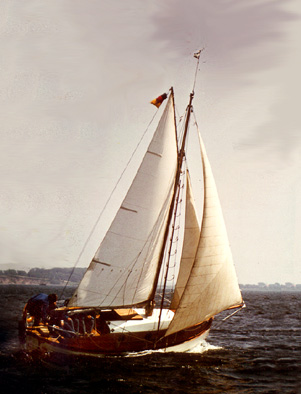Sail
|
|
A sail is a surface intended to generate thrust by being placed in a wind; basically it is a vertically oriented wing. Depending on the incident angle of the wind on the surface of the sail, one side of the sail will have a higher air pressure than the other one according to Bernoulli's principle. The difference in pressure will generate lift, causing the sail to be pulled towards the side of lower pressure. On a sailing boat, a keel or centreboard is used to convert this lateral force into forward movement of the boat with some sideways leaning, or 'heel'.
| Contents |
Use of sails

Sails are primarily used at sea, on sailing ships as a propulsion system. For purposes of commerce, sails have been largely superseded by other forms of propulsion, such as the internal combustion engine. For recreation, however, sailing vessels remain popular.
The most familiar type of sailboat, a small pleasure yacht, usually has a sail-plan called a sloop. This has two fore-and-aft sails: the mainsail and the jib.
The mainsail extends aftward and is secured the whole length of its edges to the mast and to a boom also hung from the mast. The sails of tall ships are attached to wooden timbers or "spars".
The jib is secured along its luff to a forestay (strong wire) strung from the top of the mast to the bowsprit on the bow (nose) of the boat. A genoa is also used on some boats. It is a type of jib that is larger, and cut so that it is fuller than an ordinary jib.
Fore-and-aft sails can be switched from one side of the boat to the other, in order to alter the boat's course. When the boat's stern crosses the wind, this is called jibing; when the bow crosses the wind, it is called tacking. Tacking repeatedly from port to starboard and/or vice versa, called "beating", is done in order to allow the boat to follow a course into the wind.
A primary feature of a properly designed sail is an amount of "draft", caused by curvature of the surface of the sail. When the sail is oriented into the wind, this curvature induces lift, much like the wing of an airplane. Modern sails are manufactured with a combination of broadseaming and non-stretch fabric (ref New technology below). The former adds draft, while the latter allows the sail to keep a constant shape as the wind pressure increases. The draft of the sail can be reduced in stronger winds by use of a cunningham and increasing the downward pressure of the boom.
Other sail powered machines include ice yachts and windmills.
Sail construction is governed by the science of aerodynamics.
Parts of the Sail
Parts_of_a_sail.png
The lower edge of a triangular sail is called the "foot" of the sail, while the upper point is known as the "head". The halyard, a line which raises the sail, is attached to the head. The lower two points of the sail, on either end of the foot, are called the "tack" (forward) and "clew" (aft). The tack is shackled to a fixed point on the boat such as the gooseneck in the case of a mainsail or the deck at the base of a stay in the case of a jib or staysail. The clew is movable and is positioned with running rigging, an outhaul on the mainsail and a sheet for a headsail.
The forward edge of the sail is called the "luff", from which derives the term "luffing", a rippling of the sail when the angle of the wind fails to maintain a good aerodynamic shape near the luff. The aft edge of a sail is called the "leech". If incorrectly tensioned, the leech of a sail may "flutter" noisily.
The shape of a sail however is seldom a perfect triangle. It is common for sailmakers to add sail area in an arc beyond the straight line of the leech. This additional area is called the "roach". The roach provides additional power.
Modern sails are designed such that the warp and the weft of the sailcloth are oriented parallel to the luff and foot of the sail. This places the most stretchable axis of the cloth along the diagonal axis (parallel to the leech), and makes it possible for sailors to reduce the draft of the sail by tensioning the sail, mast and boom in various ways. A cunningham may be rigged on the mainsail to control sail shape.
An alternative approach to sail design is that used in Junks, originally an oriental design. It uses horizontal sail curving to produce an efficient and easily controlled sail-plan. [1] (http://www.friend.ly.net/~dadadata/junk/tutorial.html).
New technology
Sail producers are competing hard with the latest technology to produce the best, i.e. the most efficient sail: North sails with their 3DL sail, Doyle the 4D and Elvstr÷m Sobstad the Genesis sail. These sails are produced with carbon fibers and are glued/baked, compared to the old sewed cotton sails.
See also
Types of sails
External links
The quest for the perfect sailshape (http://www.wb-sails.fi/news/98_11_PerfectShape/Main.htm)ca:Vela de Vaixell da:sejl de:segel fr:voile (navire) nl:zeil (schip) pl:┼╗agiel_(┼╝eglarstwo) ru:Парус simple:Sail
